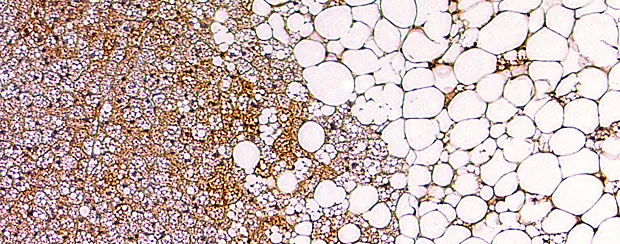The Diabat project has contributed greatly to the research on diabetes by clarifying the mechanisms that govern the in vivo activation of the brown adipose tissue (BAT) and develop a higher image technique for bat and diagnosis analysis.
Research on diabetes and obesity has progressed greatly in recent years.One of the most prominent findings is related to the operation of the BAT, a tissue where brown adipocytes are stored.In the Bat also a great activity of decomposition of lipids and glucose absorption takes place.In fact, the thermogenic capacity of even small amounts of brown adipocytes has been revealed as an attractive target to administer diabetes and obesity therapies.
For this reason, during the last four years, the project team financed with European Diabat Funds (Recruitment and Activation of Brown Adipocytes as Preventive and Curarative Therapy for Type 2 Diabetes) worked to generate innovative therapies dedicated to BAT and capable of consuming directed energy directedto people at risk and patients with type 2 diabetes.
Diabat set out to expand the knowledge that is possessed in this regard and explore the differentiation, function, dysfunction and physiological regulation of brown adipocytes in order to improve available strategies and therapies.The team in charge of the project was based on experimental cellular systems and animal models, but there were also human volunteers in which it analyzed the in situ function through image generation methods of the BAT.His method has served in tray the clinical use of experimental findings.
Shortly before Diabat, his coordinator, Dr. Tobias Schafmeier of the German Cancer Research CenterThe understanding of the in vivo activation of the BAT through endogenous, nutritional and artificial compounds and has brought to light underlying biological mechanisms of great importance.Moreover, the improvement of images of obtaining images has allowed functional analysis of the BAT in humans and improve the diagnostic methods associated with the BAT ».
There is an open debate within the scientific community about the magnitude of the BAT contribution to general energy consumption in humans.The work done by Diabat responsibles demonstrated that, even in circumstances in which energy consumption, the metabolic state of an organism improves considerably by activating the BAT.Dr. Schafmeier commented in this regard: «This can be explained by the fact that the BAT could exercise as a glucose sink and lipids, thus palling the high serum levels of these nutrients in case of obesity.It should be added that the BAT seems to fulfill a function in the endocrine system that influences more distant tissues by secreting bioactive substances (potoquins) in the bloodstream ».
Apart from the main findings on the BAT activation, the research team identified several fundamental molecular elements when differentiating adipocytes and converting white adipocytes into a phenotype similar to brown."Moreover," added Dr. Schafmeier, "important advances in the development of methodologies and techniques to study adipose tissue have been achieved.Diabat's investigation has resulted in more than one hundred publications reviewed by peers and project researchers published a special edition of Biochimica ET Biophysica Act on brown and white fats ».
The project results have enormous relevance for science to theProvide an exhaustive knowledge of the differentiation of adipocytes and the activation of the BAT.But according to Dr. Schafmeier its benefits will be extended to other professionals dedicated to obesity and diabetes: «The results also have importance for doctors thanks to the improvements in obtaining images achieved during the project.The results will also benefit nutritionists and manufacturers of dietary supplements, for example by identifying new nutritional compounds that could induce the conversion of white adipose tissue into brown ».
Ultimately, in the opinion of Dr. Schafmeier, the greatest benefited by the four years of work of the Diabat project will be patients with metabolic dysfunctions associated with obesity such as type 2 diabetes: «Improvements in obtaining images of the BATAchieved by the consortium, they will allow a more effective stratification depending on their BAT concentration, giving rise to therapies directed for those with positive bat.Food supplements characterized in the project could improve complete metabolism by induction or BAT activation ».
Looking ahead, Dr. Schafmeier is sure that the solid contacts established among the project partners will maintain: «The project partners agreed that they will adopt measures to preserve Diabat's enthusiasm and productivity.The celebration of meetings will contribute to lasting the network.Financing for network activities will be obtained and funds will be sought for the consortium as a whole or for subgroups, for example, by requesting a European Training Network Marie Sklodowska-Curie ».
For more information, see:
Diabat: Link


